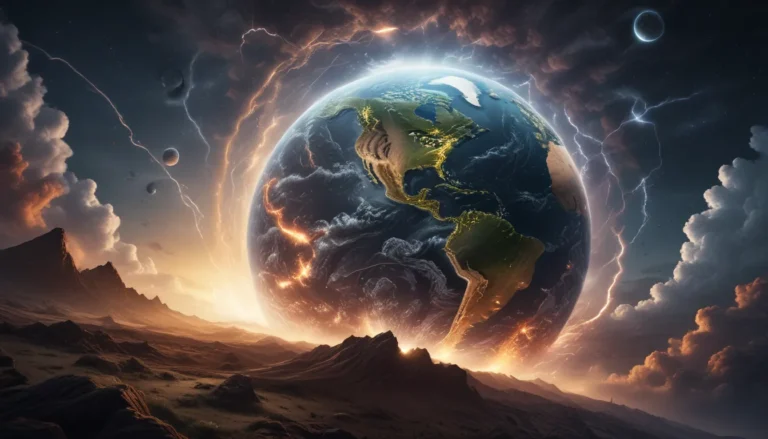A Note About Images: The images used in our articles are for illustration purposes only and may not exactly match the content. They are meant to engage readers, but the text should be relied upon for accurate information.
The world’s oceans are a captivating realm, filled with wonders that go beyond what meets the eye. One of the most intriguing aspects of these vast bodies of water is the intricate network of ocean currents that flow beneath the surface, shaping our climate, influencing weather patterns, and nurturing diverse ecosystems. In this article, we will embark on a journey into the mesmerizing world of ocean currents, uncovering 13 mind-blowing facts that will deepen your appreciation for the immense power and beauty of these underwater highways.
Unveiling the Secrets of Ocean Currents
Ocean currents are not merely streams of water moving aimlessly; they are dynamic forces that play a crucial role in shaping the Earth’s climate and weather patterns. Like nature’s own highway system for the ocean, ocean currents transport warm waters, nutrients, and marine life across vast distances, connecting different regions of the world in a delicate balance of life and energy.
The Gulf Stream: A Force of Nature
One of the most renowned ocean currents, the Gulf Stream, is a powerful and swift Atlantic current that originates in the Gulf of Mexico. This mighty current transports warm water from the tropics up the eastern coast of the United States and across the Atlantic Ocean, influencing weather patterns and marine life along its path.
The Great Ocean Conveyor Belt: A Global Symphony
The Great Ocean Conveyor Belt, also known as the thermohaline circulation, is a complex system of interconnected ocean currents that circulate heat and nutrients around the Earth. This global conveyor belt plays a vital role in regulating the planet’s climate, illustrating the intricate dance of energy and life within our oceans.
The Kuroshio Current: A Cloak of Warmth
Flowing along the eastern coast of Asia, the Kuroshio Current merges with the North Pacific Current to create the Japanese Warm Current, which significantly impacts Japan’s climate. This powerful current serves as a lifeline of warmth, shaping the weather patterns and marine ecosystems of the region.
Upwelling Currents: Nature’s Nutrient Pump
Upwelling currents, driven by winds pushing surface water away from the coast, bring nutrient-rich deep waters to the surface, supporting vibrant marine ecosystems. Essential for marine life, these currents provide a continuous supply of nutrients that sustain the delicate balance of oceanic biodiversity.
The Agulhas Current: A Force to Reckon With
Off the southeastern coast of Africa, the Agulhas Current stands as one of the strongest western boundary currents in the world. Transporting warm waters from the Indian Ocean to the South Atlantic Ocean, this formidable current influences global climate patterns, highlighting the interconnectedness of oceanic systems.
The California Current: A Cool Coastal Companion
Flowing southward along the western coast of the United States, the California Current brings cool waters from the north, influencing the climate of coastal regions such as California and Oregon. This cold oceanic current plays a pivotal role in shaping the weather conditions and marine ecosystems of the region.
The Fascinating Dance of Ocean Gyres
Ocean gyres are large systems of circular ocean currents that occur in each major ocean basin, influencing the distribution of heat, nutrients, and marine life. These spinning vortices play a critical role in regulating the Earth’s climate and enhancing the ocean’s capacity to absorb carbon dioxide, highlighting the intricate web of interconnections within our oceans.
El Niño and La Niña: Nature’s Pendulum
The El Niño and La Niña phenomena are closely tied to changes in ocean currents in the Pacific Ocean. El Niño, characterized by warm water moving eastward, and La Niña, marked by cooler sea surface temperatures in the eastern Pacific, have far-reaching impacts on global weather patterns, underscoring the delicate balance of nature’s cycles.
The Impact of Ocean Currents on Marine Debris
Ocean currents serve as carriers of marine debris, transporting waste materials across vast distances and contributing to the global issue of marine pollution. The accumulation of plastic waste, exemplified by phenomena like the Great Pacific Garbage Patch, underscores the urgent need for conservation efforts to preserve our oceans.
The Antarctic Circumpolar Current: A Force of Nature
Enveloping the Antarctic continent, the Antarctic Circumpolar Current, also known as the West Wind Drift, stands as the world’s strongest ocean current. This powerful current connects major ocean basins, redistributing heat and influencing global climate patterns, symbolizing the immense influence of ocean currents on our planet’s ecosystems.
Navigating the Seas: Insights on Marine Migration Patterns
Ocean currents not only shape the physical landscape of our oceans but also play a pivotal role in influencing the migration patterns of marine species. From sea turtles to whales, many marine organisms rely on specific currents for navigation and locating food sources along their migratory routes, highlighting the interconnected nature of oceanic ecosystems.
Conclusion: Embracing the Majesty of Ocean Currents
In conclusion, ocean currents are incredible forces of nature that wield profound influence over Earth’s climate and marine ecosystems. From the majestic speed of the Gulf Stream to the vast expanse of the Antarctic Circumpolar Current, these underwater highways connect continents, regulate temperature, and nurture life across our planet. As we unravel the mysteries of ocean currents, we gain a deeper understanding of our interconnected world and the critical role these currents play in sustaining life on Earth.
FAQs: Unraveling the Mysteries of Ocean Currents
- Q: What causes ocean currents?
-
A: Ocean currents are primarily driven by wind and differences in water density, with surface currents influenced by prevailing winds and deeper currents driven by temperature and salinity differentials.
-
Q: How fast can ocean currents flow?
-
A: Ocean currents vary in speed, with some currents moving leisurely at a few kilometers per hour and others, like the Gulf Stream, reaching speeds over 2 meters per second.
-
Q: Do ocean currents affect climate?
-
A: Yes, ocean currents have a significant impact on climate by transporting warm or cold water across vast distances, influencing temperature and weather patterns in coastal regions and beyond.
-
Q: Are ocean currents important for marine life?
-
A: Absolutely! Ocean currents play a crucial role in distributing nutrients and supporting marine ecosystems, creating feeding opportunities and guiding migration patterns for a variety of marine species.
-
Q: Can ocean currents be dangerous?
- A: Yes, some ocean currents can pose dangers, especially for swimmers and small watercraft. Strong currents like rip currents can swiftly carry individuals away from shore, posing risks to safety.
As we delve into the depths of ocean currents, we uncover a world of wonders that captivate our imagination and deepen our appreciation for the intricate interconnectedness of our planet’s natural systems. From the unseen forces shaping our climate to the unseen currents guiding marine life, ocean currents remind us of the awe-inspiring beauty and complexity of our oceans. So next time you stand at the coast gazing out at the endless expanse of the sea, take a moment to marvel at the unseen currents beneath the surface, weaving a tapestry of life that sustains us all.






